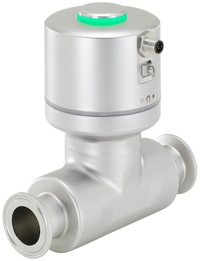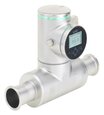Flow Meter Calibration And Verification: Ensuring Accurate Measurements

Figure 1: Flow meter
A flow meter measures a fluid's flow rate and displays it on an indicator. The flow meter should be calibrated regularly to ensure a reliable and accurate output. This article explores the various ways of calibrating a flow meter and the best practices to achieve the most accurate results. To learn more about flow meters, read our flow meter overview article.
Table of contents
- What is flow meter calibration?
- Best practices for flow meter calibration
- How to calibrate a flow meter
- Recalibration frequency
- FAQs
View our online selection of SAW (Surface Acoustic Waves) flowmeters!
What is flow meter calibration?
Flow meter calibration is done to verify and adjust the accuracy of a flow meter's measurements. Calibration plays a vital role in various industries that demand precise measurements with minimal margin for error, such as oil & gas, petrochemical, and manufacturing sectors. Flow meters are typically compared and adjusted according to a predetermined reference to ensure accurate calibration. Manufacturers may either calibrate their flow meters in-house following production or send them to independent calibration facilities for fine-tuning. The Burkert 8098 flow meter is calibrated at the factory, for example.
Best practices for flow meter calibration
Following best practices for flow meter calibration helps ensure accuracy.
- Precision: To achieve accurate flow meter calibration, the standard (master flow meter) must be precise enough for the process. As a general guideline, the chosen standard should be at least four times more accurate than the unit under test (UUT). However, specific requirements may vary according to the standardization needs.
- Traceability: Ensure that the calibration standard is traceable to a documented standard. Traceability provides a continuous chain of documentation, verifying the measurement's accuracy compared to established standards. This proof of traceability confirms that the flow meter's measurements are as accurate as claimed.
- Flow rate stability: The flow rates between the calibration standard and the UUT should be stable during calibration. Since the flow rates of the UUT and the standard are related in real-time, any fluctuations in flow over time can affect the calibration process.
- Consistent measurement: The calibration standard and the flow meter must measure the same media under similar conditions. Avoid significant temperature changes or leaks in intermediate volumes, as these factors can impact the accuracy of the measurement.
- Calibration conditions: Perform calibration under conditions that closely resemble the flow meter's operating environment. This helps ensure that the calibration process accurately reflects the needs in which the flow meter will function.
How to calibrate a flow meter
Flow meter calibration is done by various methods, all of which consist of comparing the flow meter against a reference flow meter of higher accuracy. In the United States, the National Institute of Standards and Technology (NIST) serves as the standard for calibration, whereas, for most European countries, the Van Swinden Laboratory in the Netherlands provides the calibration benchmark. The most common calibration processes are discussed below.
Master meter calibration
Master meter calibration involves the comparison of a flow meter's readings with the measurements obtained from a calibrated reference device called a master meter. It is typically carried out in a controlled laboratory environment or specialized calibration facility. Perform the following steps for master meter calibration:
- Setup: Set up the master meter and the flow meter being tested in series, with a controlled flow rate passing through both devices simultaneously. Vary the flow rate across a range of values to assess the linearity and performance of the flow meter being tested.
- Comparison: Compare the flow meter's readings to the master meter's readings. Record and analyze discrepancies or deviations between the flow meter and the master meter. Use these differences to create calibration curves or tables. Apply the correction factors from the curves or tables to align the flow meter's measurements with the master meter's measurements.
Gravimetric calibration
Gravimetric calibration is a highly accurate and cost-efficient mass and volumetric flow meter calibration method. This approach is well-suited for liquid flow meter calibration in water purification, oil, and fuel industries. The main steps in gravimetric calibration are outlined below:
- Setup: The flow meter being calibrated is installed in a test rig, along with appropriate inlet and outlet connections. The test rig allows accurate measurement of the fluid passing through the flow meter.
- Mass measurement: A highly accurate weighing device, such as a balance or load cell, measures the mass of the fluid passing through the flow meter. The weighing device is carefully calibrated before flow meter calibration to ensure accuracy.
- Time measurement: The flow measurement's time duration is recorded using synchronized timers or other time measurement devices.
- Flow measurement: The fluid passes through the flow meter for a specified period while the mass of the fluid is continuously monitored using the weighing device. The flow rate is calculated by dividing the measured mass by the estimated time.
- Calibration curve: Multiple flow rate measurements are performed at different known flow rates to create a calibration curve. The calibration curve relates the flow meter's readings to flow rates. It helps establish the flow meter's linearity and determine the corrections for future flow measurements.
Piston prover calibration
A piston prover is a specialized and highly precise device designed to measure and verify flow rates. The piston prover is a primary standard, providing traceability to recognized measurement standards. Here's a step-by-step guide to the piston prover method of flow meter calibration:
- Setup: The flow meter being calibrated connects to the piston prover through appropriate inlet and outlet connections. The piston prover consists of a cylinder and a piston; the piston's movement is precisely controlled using mechanical or hydraulic systems.
- Calibration of piston prover: Before calibrating the flow meter, the piston prover is calibrated using a highly accurate reference standard. This calibration ensures that the piston prover is accurate and provides reliable measurements.
- The calibration runs: Fluid flows through the flow meter while the piston prover simultaneously operates. The piston prover measures the flow rate independently.
- Comparison: The flow rate obtained from the flow meter is compared to that obtained from the piston prover. Any discrepancies or errors in the flow meter's readings are noted.
- Correction factors: Calibration factors or correction values are determined by comparing the flow meter and the piston prover measurements. These correction factors are applied to the flow meter's readings to adjust and align them with the piston prover's measures.
Recalibration frequency
Periodic flow meter recalibration is crucial, as flow meter readings may drift from their actual values over time due to the variable conditions present in industrial operations. The primary distinction between the initial flow calibration and recalibration lies in their respective timelines. Flow calibration is conducted before the meter leaves the factory, while recalibration occurs after the meter has been in service for some time. Additionally, software tools can be employed to verify the accuracy of the measurements post-calibration. Flow meters are typically recalibrated according to the manufacturer's guidelines, regulatory requirements, and historical data analysis.
FAQs
Why is flow meter calibration important?
Flow meter calibration is crucial because it ensures the accuracy of flow measurements, which are vital for industrial manufacturing, fluid distribution, and energy management.
How often should you calibrate a flow meter?
Calibrate the flow meter at least once every six months to yield the most accurate results.





